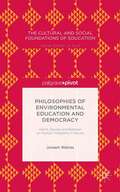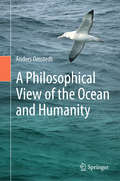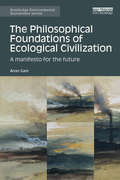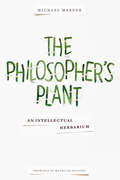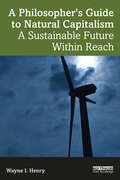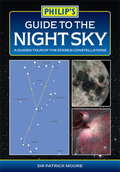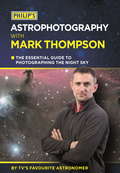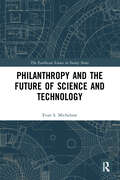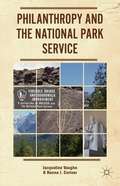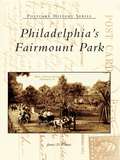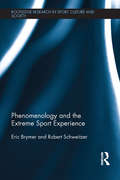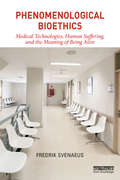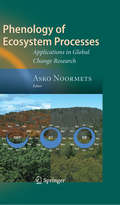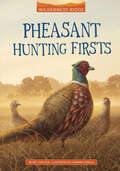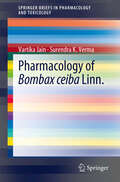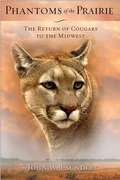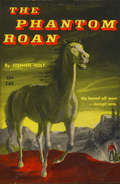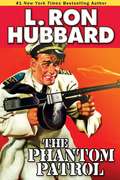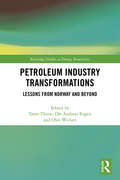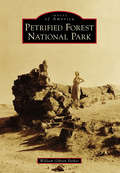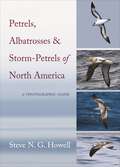- Table View
- List View
Philosophies of Environmental Education and Democracy: Harris, Dewey, and Bateson on Human Freedoms in Nature
by Joseph WatrasThe project examines how three prominent philosophers of education - William Torrey Harris, John Dewey, and Gregory Bateson - each developed a world view that provides a philosophical basis for environmental education.
A Philosophical View of the Ocean and Humanity (Springerbriefs In Environmental Science Ser.)
by Anders OmstedtThis book is about the ocean and about the future. It is written in two modes, a concerned analytical scientific mode and an intuitive artistic mode in which the ocean is given a voice. The disconnect in the relationship between human dependency on and feelings about the ocean is examined in a dialogue between these two modes. The book illustrates how science and the arts can be connected to increase our awareness of the state of the ocean and support behavioural change. This book is intended for everyone who would like to contribute to the sustainable use of the ocean. Includes forewords by Alice Newton, University of Algarve, Portugal and Martin Visbeck, GEOMAR, Helmholtz Centre for Ocean Research, Kiel, Germany.
The Philosophical Foundations of Ecological Civilization: A manifesto for the future (Routledge Environmental Humanities)
by Arran GareThe global ecological crisis is the greatest challenge humanity has ever had to confront, and humanity is failing. The triumph of the neo-liberal agenda, together with a debauched ‘scientism’, has reduced nature and people to nothing but raw materials, instruments and consumers to be efficiently managed in a global market dominated by corporate managers, media moguls and technocrats. The arts and the humanities have been devalued, genuine science has been crippled, and the quest for autonomy and democracy undermined. The resultant trajectory towards global ecological destruction appears inexorable, and neither governments nor environmental movements have significantly altered this, or indeed, seem able to. The Philosophical Foundations of Ecological Civilization is a wide-ranging and scholarly analysis of this failure. This book reframes the dynamics of the debate beyond the discourses of economics, politics and techno-science. Reviving natural philosophy to align science with the humanities, it offers the categories required to reform our modes of existence and our institutions so that we augment, rather than undermine, the life of the ecosystems of which we are part. From this philosophical foundation, the author puts forth a manifesto for transforming our culture into one which could provide an effective global environmental movement and provide the foundations for a global ecological civilization.
The Philosopher's Plant: An Intellectual Herbarium
by Michael MarderDespite their conceptual allergy to vegetal life, philosophers have used germination, growth, blossoming, fruition, reproduction, and decay as illustrations of abstract concepts; mentioned plants in passing as the natural backdrops for dialogues, letters, and other compositions; spun elaborate allegories out of flowers, trees, and even grass; and recommended appropriate medicinal, dietary, and aesthetic approaches to select species of plants.In this book, Michael Marder illuminates the vegetal centerpieces and hidden kernels that have powered theoretical discourse for centuries. Choosing twelve botanical specimens that correspond to twelve significant philosophers, he recasts the development of philosophy through the evolution of human and plant relations. A philosophical history for the postmetaphysical age, The Philosopher's Plant reclaims the organic heritage of human thought. With the help of vegetal images, examples, and metaphors, the book clears a path through philosophy's tangled roots and dense undergrowth, opening up the discipline to all readers.
A Philosopher's Guide to Natural Capitalism: A Sustainable Future Within Reach
by Wayne I. HenryThis book posits that a sustainable future is possible without abandoning Capitalism. In its current form as Consumer Capitalism, the organization of the global economy is clearly unsustainable. But Capitalism is a malleable concept that has assumed a variety of forms since the 17th century, and it can be altered as needed. In Part I of this book, the author sets out an economic model for a sustainable form of Capitalism, referred to in the literature as Natural Capitalism. In Part II, he abandons exposition in favour of rigorous philosophical analysis and critiques the older but still dominant narrative that underlies Classical Liberalism. The narrative will be reconstructed with great care and analysed to understand why it has been so powerful and enduring, and, of course, why it is no longer appropriate for our current circumstances. In Part III, he investigates from a normative perspective Classical Liberalism and globalized Capitalism and the economic system it licenses. Finally, in the conclusion, the author draws the threads of the discussion together in a way that emphasizes the differences between the two narratives, Classical Liberalism on the one hand and the contemporary version of Progressive Liberalism that nurtures and supports Natural Capitalism on the other. This book will be of interest to a broad range of scholars and curious laypersons interested in a clear and interdisciplinary presentation of the issues arising out of climate change, including corporate governance, social and environmental policy, declining social capital and the capacity of democratic institutions to deal effectively with sustainability. It will be particularly relevant for students and instructors of philosophy, history, economics, political science, social policy and environmental sociology.
Philip's Guide to the Night Sky: A Guided Tour Of The Stars And Constellations (Philip's Astronomy Ser.)
by Sir Patrick MooreFind your way around the night sky with this handy guide to stargazing for the complete novice. In Philip's Guide to the Night Sky, Sir Patrick Moore explains how to find the most famous constellations and the brightest stars, and when to look for them. Clear star maps, showing stars visible to the naked eye, help you to navigate the skies. The maps are suitable for use in Britain, Ireland, northern Europe and Canada.Sir Patrick introduces the wonders of the night sky to absolute beginners in his characteristically entertaining and informative style. The Moon, the planets, the Sun and the stars are explained in non-technical language, while the constellations are described with the help of star maps and tables.The four main chapters in Philip's Guide to the Night Sky are devoted to what's on view in each season of the year. The information is appropriate for observers in Britain and Ireland, northern Europe and Canada; it will also be helpful a little outside these latitudes. Using prominent patterns, such as the Plough and Orion, Sir Patrick teaches the reader to 'star-hop' from constellation to constellation, thus learning to navigate the night sky. Star maps and photographs illustrate and clarify what will be on view. Philip's Guide to the Night Sky is an ideal introduction to stargazing, suitable for all ages and with no need for anything more technical than the naked eye.
Philip's Guide to the Night Sky: A guided tour of the stars and constellations (Philip's Guide to...)
by Sir Patrick MooreFind your way around the night sky with this handy guide to stargazing for the complete novice. In Philip's Guide to the Night Sky, Sir Patrick Moore explains how to find the most famous constellations and the brightest stars, and when to look for them. Clear star maps, showing stars visible to the naked eye, help you to navigate the skies. The maps are suitable for use in Britain, Ireland, northern Europe and Canada.Sir Patrick introduces the wonders of the night sky to absolute beginners in his characteristically entertaining and informative style. The Moon, the planets, the Sun and the stars are explained in non-technical language, while the constellations are described with the help of star maps and tables.The four main chapters in Philip's Guide to the Night Sky are devoted to what's on view in each season of the year. The information is appropriate for observers in Britain and Ireland, northern Europe and Canada; it will also be helpful a little outside these latitudes. Using prominent patterns, such as the Plough and Orion, Sir Patrick teaches the reader to 'star-hop' from constellation to constellation, thus learning to navigate the night sky. Star maps and photographs illustrate and clarify what will be on view. Philip's Guide to the Night Sky is an ideal introduction to stargazing, suitable for all ages and with no need for anything more technical than the naked eye.
Philip's Astrophotography With Mark Thompson: The Essential Guide To Photographing The Night Sky By TV's Favourite Astronomer
by Mark ThompsonPhilip's Astrophotography With Mark Thompson is an essential guide for anyone wishing to photograph or image the stars and planets, written by TV's favourite astronomer. For many people, looking at the sky is not enough and they would love to try and capture what they can see. Until a few years ago, capturing astronomical images was fraught with many challenges, but with the development of digital cameras replacing film, things have become much easier and great astronomical images are now within the reach of even the most novice stargazer. Mark Thompson has spent many years capturing the beauty of the night sky, first with film and now with the digital camera, and has discovered and overcome many of the pitfalls. This book takes the reader on a journey through the world of capturing astronomical images from using the humble mobile phone to specialist cameras, brought to life with Mark's personal experiences and many of his own astronomical images.
Philanthropy and the Future of Science and Technology (The Earthscan Science in Society Series)
by Evan S. MichelsonAn increasingly important and often overlooked issue in science and technology policy is recognizing the role that philanthropies play in setting the direction of research. In an era where public and private resources for science are strained, the practices that foundations adopt to advance basic and applied research needs to be better understood. This first-of-its-kind study provides a detailed assessment of the current state of science philanthropy. This examination is particularly timely, given that science philanthropies will have an increasingly important and outsized role to play in advancing responsible innovation and in shaping how research is conducted. Philanthropy and the Future of Science and Technology surveys the landscape of contemporary philanthropic involvement in science and technology by combining theoretical insights drawn from the responsible research and innovation (RRI) framework with empirical analysis investigating an array of detailed examples and case studies. Insights from interviews conducted with foundation representatives, scholars, and practitioners from a variety of sectors add real-world perspective. A wide range of philanthropic interventions are explored, focusing on support for individuals, institutions, and networks, with attention paid to the role that science philanthropies play in helping to establish and coordinate multi-sectoral funding partnerships. Novel approaches to science philanthropy are also considered, including the emergence of crowdfunding and the development of new institutional mechanisms to advance scientific research. The discussion concludes with an imaginative look into the future, outlining a series of lessons learned that can guide how new and established science philanthropies operate and envisioning alternative scenarios for the future that can inform how science philanthropy progresses over the coming decades. This book offers a major contribution to the advancement of philanthropic investment in science and technology. Thus, it will be of considerable interest to researchers and students in public policy, public administration, political science, science and technology studies, sociology of science, and related disciplines.
Philanthropy And The National Park Service
by Jacqueline Vaughn Hanna J. CortnerAs the National Park Service prepares for its centennial in 2016, this book provides an in-depth analysis of the role of philanthropy in national parks, with a focus on non-profit organizations known as friends groups and cooperating associations. Providing a historical review of partnerships through the lifetime of the NPS, up to a contemporary analysis of the legal and organizational framework under which non-profit philanthropic partners operate, Jacqueline Vaughn and Hanna J. Cortner explore the challenges the National Park Service faces in dealing with non-profit partners. Based on personal interviews with more than 50 non-profit leaders and National Park Service staff, financial data, and comprehensive site visits, Vaughn and Cortner offer a unique and informative view of the landscape in which philanthropy groups succeed - and sometimes fail.
Philadelphia's Fairmount Park
by James D. RistinePhiladelphia's Fairmount Park focuses on the more than four thousand acres of land along the east and west banks of the Schuylkill River and into parts of the Wissahickon Valley that comprise one of the world's largest urban parks. Historically and architecturally important structures and buildings are chronicled, such as the famous waterworks, the many bridges that span the park's waterways, the Zoological Gardens, and Boathouse Row. Numerous fountains, monuments, and artistic sculptures that dot the landscape are also documented. Rich in natural beauty, the park's meadows, gardens, lush vegetation, rugged ravines, and wooded areas will capture the eye. Philadelphia's Fairmount Park is a nostalgic view of the park as it was enjoyed by visitors during the first quarter of the twentieth century.
Phenomenology and the Extreme Sport Experience (Routledge Research in Sport, Culture and Society)
by Eric Brymer Robert SchweitzerUnderstanding the motivations behind those who partake in extreme sports can be difficult for some. If the popular conception holds that the incentive behind extreme sports participation is entirely to do with risking one’s life, then this confusion will continue to exist. However, an in-depth examination of the phenomenology of the extreme sport experience yields a much more complex picture. This book revisits the definition of extreme sports as those activities where a mismanaged mistake or accident would most likely result in death. Extreme sports are not necessarily synonymous with risk and participation may not be about risk-taking. Participants report deep inner transformations that influence world views and meaningfulness, feelings of coming home and authentic integration as well as a freedom beyond the everyday. Phenomenologically, these experiences have been interpreted as transcendent of time, other, space and body. Extreme sport participation therefore points to a more potent, life-enhancing endeavour worthy of further investigation. This book adopts a broad hermeneutic phenomenological approach to critique the assumed relationship to risk-taking, the death wish and the concept of "No Fear" in extreme sports, and repositions the experience in a previously unexplored manner. This is valuable reading for students and academics interested in Sports Psychology, Social Psychology, Health Psychology, Tourism, Leisure Studies and the practical applications of phenomenology.
Phenomenological Bioethics: Medical Technologies, Human Suffering, and the Meaning of Being Alive
by Fredrik SvenaeusEmerging medical technologies are changing our views on human nature and what it means to be alive, healthy, and leading a good life. Reproductive technologies, genetic diagnosis, organ transplantation, and psychopharmacological drugs all raise existential questions that need to be tackled by way of philosophical analysis. Yet questions regarding the meaning of life have been strangely absent from medical ethics so far. This book brings phenomenology, the main player in the continental tradition of philosophy, to bioethics, and it does so in a comprehensive and clear manner. Starting out by analysing illness as an embodied, contextualized, and narrated experience, the book addresses the role of empathy, dialogue, and interpretation in the encounter between health-care professional and patient. Medical science and emerging technologies are then brought to scrutiny as endeavours that bring enormous possibilities in relieving human suffering but also great risks in transforming our fundamental life views. How are we to understand and deal with attempts to change the predicaments of coming to life and the possibilities of becoming better than well or even, eventually, surviving death? This is the first book to bring the phenomenological tradition, including philosophers such as Martin Heidegger, Edith Stein, Maurice Merleau-Ponty, Jean-Paul Sartre, Hans-Georg Gadamer, Paul Ricoeur, Hans Jonas, and Charles Taylor, to answer such burning questions.
Phenology of Ecosystem Processes
by Asko NoormetsTerrestrial carbon balance is uncertain at the regional and global scale. A significant source of variability in mid-latitude ecosystems is related to the timing and duration of phenological phases. Spring phenology, in particular, has disproportionate effects on the annual carbon balance. However, the traditional phenological indices that are based on leaf-out and flowering times of select indicator species are not universally amenable for predicting the temporal dynamics of ecosystem carbon and water exchange. Phenology of Ecosystem Processes evaluates current applications of traditional phenology in carbon and H2O cycle research, as well as the potential to identify phenological signals in ecosystem processes themselves. The book summarizes recent progress in the understanding of the seasonal dynamics of ecosystem carbon and H2O fluxes, the novel use of various methods (stable isotopes, time-series, forward and inverse modeling), and the implications for remote sensing and global carbon cycle modeling. Each chapter includes a literature review, in order to present the state-of-the-science in the field and enhance the book's usability as an educational aid, as well as a case study to exemplify the use and applicability of various methods. Chapters that apply a specific methodology summarize the successes and challenges of particular methods for quantifying the seasonal changes in ecosystem carbon, water and energy fluxes. The book will benefit global change researchers, modelers, and advanced students.
Pheasant Hunting Firsts (Wilderness Ridge)
by Art CoulsonEleven-year-old Zach Feather can't wait to go on his first pheasant hunting trip, especially when he learns his parents have a surprise for him—a new bird dog! The family travels across the state from the Cherokee reservation in eastern Oklahoma to hunt pheasant on a relative's ranch. There are more surprises—including a rattlesnake encounter—in store for Zach on his first hunt. Along the way, he learns that hunting is about more than just finding pheasants. It's also about patience and the things in life that are most important—hunting with his dog and his family.
Pharmacology of Bombax ceiba Linn.
by Vartika Jain Surendra K. VermaThis work is the first monograph devoted solely to Bombax ceiba, popularly known as the Red Silk Cotton Tree. Consisting of seven chapters, it covers all relevant aspects of this plant, from its historical and spiritual importance, to its botanical characterization, pharmacognostical details and ethnobiological uses, to its scientific validation in various animal and human studies. Each part of the tree is of medicinal value and possesses many novel chemical constituents such as shamimicin, bombasin, bombamalone, bombamaloside etc. along with other bioactive secondary metabolites. The book presents the chemical structures of the most important constituents and highlights various pharmacological activities, predominantly antioxidant, anti-inflammatory, anti-mutagenic, hypoglycemic, hypotensive, hepatoprotective and fibrinolytic, which may prove to be a source for the development of a novel phyto-pharmaceutical agent to treat diabetes, heart disease and cancer. In addition, separate chapters deal with the commercial and ecological significance of B. ceiba, as well as a case study on its conservation. Numerous color illustrations are included to identify the plant and to justify its nickname, the "Little Bird's Cafeteria".
Phantoms of the Prairie
by John W. LaundréLast seen in the 1880s, cougars (also known as pumas or mountain lions) are making a return to the plains regions of the Midwest. Their comeback, heralded by wildlife enthusiasts, has brought concern and questions to many. Will the people of the region make room for cougars? Can they survive the highly altered landscape of the Midwest? Is there a future for these intrepid pioneers if they head even farther east? Â Â Â Using GIS technology, and historical data, among many other methods, Phantoms of the Prairie takes readers on a virtual journey, showing how the cougar might move over the landscape with minimal human contact. Drawing on his years of research on cougars, John W. Laundré offers an overview of what has been, what is, and what might be regarding the return of cougars to their ancestral prairie homeland.
The Phantom Roan (Famous Horse Stories)
by Stephen HoltThe roan waved his foot back and forth in ceaseless pain. "I thought so," muttered Glenn. "It's a rock in the frog." He pulled a pocketknife from his levis. Sterilizing the blade in the fire, he probed for the rock. It came free--a three-cornered jagged piece of granite. And so begins a partnership of boy and horse that climaxes in the Rodeo in New York's Madison Square Garden.
Phantom Patrol, The
by L. Ron HubbardA triumphant tale of heroes, honor and impossible odds. On the trail of dope runners on the high seas, Coast Guard CPO Johnny Trescott receives an SOS from a transport plane that's crashed and sinking. With lives at stake, Johnny must cut off his pursuit and rescue the downed plane.Unfortunately, the dope-smuggling pirate he's chasing hears the same alarm, and greets Johnny and his crew at the crash scene with something far more than they bargained for."This is a rip-roaring, old-fashioned adventure like the kind they don't make any more. A blast for Hubbard fans and pulp fiction lovers."--Library Journal* An International Book Awards Finalists
Pets Gone Green
by Eve AdamsonIn Pets Gone Green, New York Times best-selling author Eve Adamson explores how pet owners can have a positive effect on the environment and their pets' place within it. This engaging and enlightening book outlines strategies that pet owners can pursue to reduce the family's carbon foot- and pawprints, from using less toxic flea repellant to offering earth-friendly treats and toys to our much-loved pets. Adamson's goal in writing Pets Gone Green stemmed from her desire to find ways to save her dogs from the increasingly toxic environment around us. "...we are obligated to speak up for our furry companions, who are unable to think or act green on their own." Pets Gone Green remains a timely exploration of many of the hot-button topics in our world today, from eating local and animal rescue to activism and recycling! The book offers practical advice for owners of all pets, from dogs and cats to birds, small mammals, and more.As pet rescue has increasingly become "the thing to do," the book begins with a chapter on "Recycled Companions: The Ultimate Earth-Friendly Act," in which the author discusses the many advantages of rescuing a pet from a shelter or rescue society. Pet food, another hot topic in the pet world, is the subject of "Green Food," which includes a brief history of commercial food and the pluses and minuses of using natural, homemade, raw, and vegetarian diets for pets. The chapter "Altered States" is devoted to the importance and health benefits of spaying and neutering pets. Buying and eating local, diminishing consumerism, organic materials, holistic pet care, and recycling are all discussed in terms of improving humans' and pets' lives and reducing waste on a community, national, and global level.Printed with soy ink on recycled paper, Pets Gone Green presents the original artwork of New England painter and woodblock printmaker Willy Reddick. The book includes over 50 woodblock images of her beautiful peaceful animals, lending a down-home organic feel that is truly unique for a pet book.The ultimate message of the book is summarized in the final chapter "Animal Wisdom," in which Adamson focuses in on what our pets can teach us about the world around us through their natural instincts, simplicity, and view of the world. She concludes, "...animals are companions worthy of our respect, love, and care, and because they are so close to nature in ways we can only begin to comprehend, they are also the key to our salvation....Animals understand how to live lightly on the earth, and we can learn from them." Resources of animal welfare websites and agencies, green organizations, holistic resources, green product manufacturers, and green websites and publications included. Fully indexed.
Petroturfing: Refining Canadian Oil through Social Media
by Jordan B. KinderHow social media has become a critical tool for advancing the interests of the Canadian oil industry Petroturfing presents an incisive look into how Canada&’s pro-oil movement has leveraged social media to rebrand the extractive economy as a positive force. Adapting its title from the concept of astroturfing, which refers to the practice of disguising political and corporate media campaigns as grassroots movements, the book exposes the consequences of this mutually informed relationship between social media and environmental politics. Since the early 2010s, an increasingly influential network of pro-oil groups, organizations, and campaigns has harnessed social media strategies originally developed by independent environmental organizations in order to undermine resistance to the fossil fuel industry. Situating these actions within the broader oil culture wars that have developed as an outgrowth of contemporary right-wing media, Petroturfing details how this coalition of groups is working to reform the public view of oil extraction as something socially, economically, and ecologically beneficial. By uncovering these concerted efforts to influence the &“energy consciousness,&” Jordan B. Kinder reveals the deep divide between Canada&’s environmentally progressive reputation and the economic interests of its layers of government and private companies operating within its borders. Drawing attention to the structures underlying online political expression, Petroturfing highlights the limitations of social media networks in the work of promoting environmental justice and contributing to a more equitable future.
Petroleum Industry Transformations: Lessons from Norway and Beyond (Routledge Studies in Energy Transitions)
by Taran Thune Ole Andreas Engen Olav WickenTaking the case of the Norwegian petroleum industry as its vantage point, the book discusses the question of industrial transformations in resource-based industries. The book presents new, empirically-based analyses of the development of the petroleum industry, with an emphasis on three ongoing transformation processes: Technological upgrading and innovation in upstream petroleum. Globalisation of the petroleum industry and suppliers’ experiences of entering foreign markets. Diversification into and out of petroleum – and the potential for new growth paths after oil. Drawing together a range of key thinkers in this field, this volume addresses the ways in which the petroleum industry and its supply industry has changed since the turn of the millennium. It provides recommendations for the development of resource economies in general and petroleum economies in particular. This book will be of great interest to students and scholars of energy policy and economics, natural resource management, innovation studies and the politics of the oil and gas sector.
Petroleum Economics and Engineering
by Hussein K. Abdel-Aal Mohammed A. AlsahlawiThis book explains how to apply economic analysis to the evaluation of engineering challenges in the petroleum industry. Discussion progresses from an introduction to the industry, through principles and techniques of engineering economics, to the application of economic methods. Packed with real-world examples and case studies demonstrating how to
Petrified Forest National Park (Images of America)
by William Gibson ParkerPetrified Forest National Park in Northeast Arizona was set aside in 1906 by Pres. Theodore Roosevelt to protect the scientifically important Mesozoic forests. With a boundary encompassing 225,000 acres, the park protects not only the largest and most colorful deposits of petrified wood in the world but also significant archeological and ecological resources and other important fossils, like the oldest dinosaurs in North America. The park has been a crossroads for travelers and a destination for scientists, including Albert Einstein and John Muir. As a work site of the Civilian Conservation Corps, the only national park crossed by the famous Route 66, and a centerpiece of the National Park Service's Mission 66 initiative, Petrified Forest National Park has a history that rivals that of more familiar national parks.
Petrels, Albatrosses, and Storm-Petrels of North America: A Photographic Guide
by Steve N. HowellA complete illustrated guide to these enigmatic seabirdsPetrels, albatrosses, and storm-petrels are among the most beautiful yet least known of all the world's birds, living their lives at sea far from the sight of most people. Largely colored in shades of gray, black, and white, these enigmatic and fast-flying seabirds can be hard to differentiate, particularly from a moving boat. Useful worldwide, not just in North America, this photographic guide is based on unrivaled field experience and combines insightful text and hundreds of full-color images to help you identify these remarkable birds.The first book of its kind, this guide features an introduction that explains ocean habitats and the latest developments in taxonomy. Detailed species accounts describe key identification features such as flight manner, plumage variation related to age and molt, seasonal occurrence patterns, and migration routes. Species accounts are arranged into groups helpful for field identification, and an overview of unique identification challenges is provided for each group. The guide also includes distribution maps for regularly occurring species as well as a bibliography, glossary, and appendixes.The first state-of-the-art photographic guide to these enigmatic seabirdsIncludes hundreds of full-color photos throughoutFeatures detailed species accounts that describe flight, plumage, distribution, and moreProvides overviews of ocean habitats, taxonomy, and conservationOffers tips on how to observe and identify birds at sea
